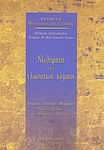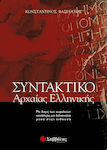Skroutz Buyers Protection
Πώς διαβάζεις έναν πίνακα ζωγραφικήςCode: 17101600
- Author: Louis Marin
- Publisher: Morfotiko Idryma Ethnikis Trapezis
- Μορφή: Soft Cover
- Έτος έκδοσης: 2018
- Αριθμός σελίδων: 95
- Κωδικός ISBN-13: 9789602507292
Similar products





Language & Philology Books
Η μετάφραση των οικονομικών κειμένων, Μια λειτουργική προσέγγιση
from 10,97 €Added
Language & Philology Books
Μη-συμβατικές θεωρίες, Οι κερδοσκόποι του "ελληνισμού" και ο φενακισμός των αφελών
Added
Language & Philology Books
Ν(ο)ήματα και γλωσσικοί κόμποι, Κείμενα φιλοσοφίας της γλώσσας
from 10,90 €Added




Language & Philology Books
Γραμματική Αρχαίας Ελληνικής, της Αττικής Πεζογραφικής Διαλέκτου, για το Γυμνάσιο και το Λύκειο
Ad from BooklibertyAdded
All shops
Prices are calculated for:Malta, Other Payment Options
- 10,76 €
- 10,76 €
Description
We read a letter, a poem, a book. But how do we read a work of art? We look at a painting, we may admire it immediately or it may leave us indifferent, even displeased, and then we pass it by. However, when we observe it persistently, always from a distance, like in a museum hall, we feel that we have stood in front of it for hours not only because its sight pleases us, but because it has something to tell us, to narrate to us. We then begin to recognize that, "written" in its own language, the painting requires us to "read" it. This paradoxical reading function of the idiomatic language of painting is analyzed by Louis Marin in his essay; to illuminate the intersecting boundaries of the intelligible and the visible: from the representational symbolic painting of Nicolas Poussin - where myth and History take on the narration - traversing the art of the 17th-18th century through the silent still lifes of Philippe de Champaigne, Lubin Baugin, and Jean-Baptiste Siméon Chardin, to modern art, with examples such as the abstract painting of Piet Mondrian and Paul Klee, the author highlights the universality and autonomy of painting's representational significance, describing the pleasure of the gaze when it manages to read the visible as a letter and to look at the intelligible as matter.
Specifications
- Genre
- -
- Format
- Soft Cover
- Number of Pages
- 95
- Publication Date
- 2018
Important information
Specifications are collected from official manufacturer websites. Please verify the specifications before proceeding with your final purchase. If you notice any problem you can report it here.







































